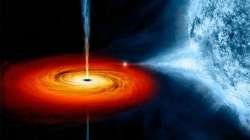How the Big Bang may have happened decoded
"We defined the critical criteria where we can drive a flame to self-generate its own turbulence, spontaneously accelerate, and transition into detonation," said Kareem Ahmed, an assistant professor at the University of Central Florida in the US.

The universe began with the Big Bang, and now scientists have explained how the mysterious explosion may have taken place around 13.8 billion years ago. The Big Bang theory states that all matter that exists today in the universe sprung forth from a single point in an epic explosion.
The research, published in the journal Science, details the mechanisms that could cause the explosion, which is key for the models that scientists use to understand the origin of the universe.
"We defined the critical criteria where we can drive a flame to self-generate its own turbulence, spontaneously accelerate, and transition into detonation," said Kareem Ahmed, an assistant professor at the University of Central Florida in the US.
"We are using the turbulence to enhance the mixing of the reactions to the point where it transitions into this violent reaction and essentially leads to supernovas, which is exploding stars in simple terms," Ahmed, co-author of the study, wrote in the journal.
"We are taking a simplified flame to where it's reacting at five times the speed of sound," he explained.
The team uncovered the criteria for creating a Big Bang-type explosion while exploring methods for hypersonic jet propulsion.
"We explore these supersonic reactions for propulsion, and as a result of that, we came across this mechanism that looked very interesting," said Ahmad.
"When we started to dig deeper, we realised that this is relatable to something as profound as the origin of the universe," he said in statement.
The key is applying the right amount of turbulence and mixing to an unconfined flame until it becomes self-perpetuating, at which point the flame begins to burn the ingested energy leading to a hypersonic -- exceeding the speed of sound -- supernova explosion.
The finding may have applications in faster air and space travel, and improved power generation, including reactions that generate zero emissions as all of the products used in the combustion are converted into energy, the researchers said.
The discovery was made by using a unique turbulent shock tube that allowed explosions to be created and analysed in a contained environment, they said.
The researchers noted that ultra-high-speed lasers and cameras were used to measure the explosions and help indicate what factors were needed to reach the point where a flame becomes a hypersonic, violent reaction.
ALSO READ | 'Green inhalers' can drastically cut down carbon footprint and med costs: Study
ALSO READ | Some plants may depend more on friendly fungi than own leaves: Study